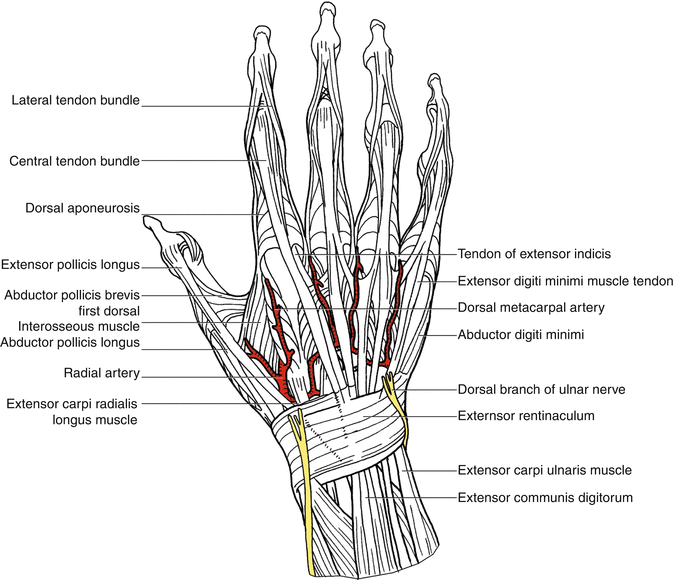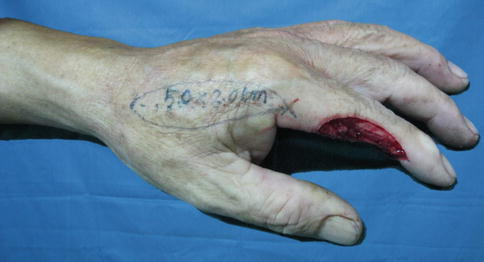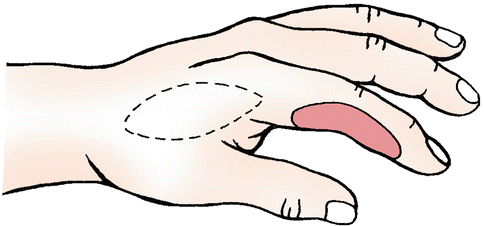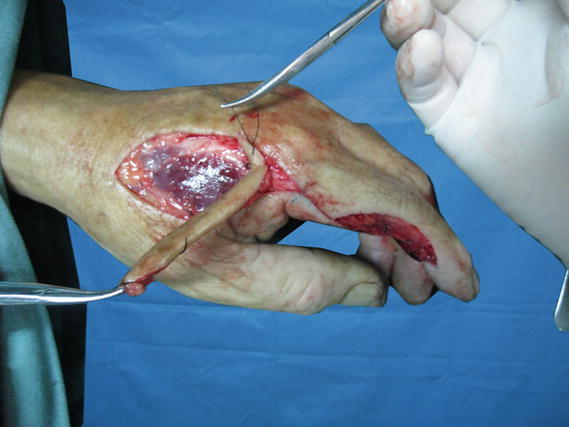, Shimin Chang2, Jian Lin3 and Dajiang Song1
(1)
Department of Orthopedic Surgery, Changzheng Hospital Second Military Medical University, Shanghai, China
(2)
Department of Orthopedic Surgery, Yangpu Hospital Tongji University School of Medicine, Shanghai, China
(3)
Department of Microsurgery, Xinhu Hospital Shanghai Jiao Tong University, Shanghai, China
The first dorsal metacarpal artery (FDMA) flap (kite flap) was firstly described by Foucher and Braun [1].
As firstly described by Quaba and Davison [2], the DMA (dorsal metacarpal artery) flap can be harvested without incorporating the DMA [3]. This flap is based on cutaneous perforators originating from the DMAs.
This flap does not include the DMA, and its vascular supply is based solely on the cutaneous perforator emanating either directly from the DMA or from the communicating branch between the DMA and the palmar metacarpal artery.
14.1 Vascular Anatomy
The blood supply to the dorsal skin of the hand and digits is provided by (1) the DMAs, which vascularize the proximal portion of the hand, and (2) the dorsal perforating metacarpal arterial branches from the deep palmar arch, which supply the distal hand and proximal phalanx [4]. These two major arterial systems form the basis for direct and reverse DMA flaps (Fig. 14.1).


Fig. 14.1
Vascular anatomy of the first dorsal metacarpal artery
The cutaneous perforator is very reliable and can almost always be found within the second through the fourth intermetacarpal spaces roughly 1 cm proximal to the metacarpal neck. This is in sharp contrast to the third and fourth DMAs, which can sometimes be absent.
The FDMA originated from the radial artery or the dorsalis superficialis antebrachialis artery. There are vascular connections between the dorsal digital branches of the second through fourth DMA arteries and the dorsal branches of the PPD arteries. These connections make it possible to harvest an extended reverse DMA flap based on retrograde flow from the dorsal branches of the PPD artery.
The second dorsal metacarpal artery (SDMA) generally runs along a line joining the anatomic snuffbox and second webspace. The SDMA originated from the dorsal carpal arch or the deep palmar arch, the FDMA, the anterior interosseous artery, or the radial artery [5].
14.2 Illustrative Case
Case 1
This 18-year-old man was operated on using this procedure. He sustained a work-related injury. The index finger was involved, and the skin defect was located over the proximal interphalangeal (PIP) joint (Fig. 14.2).


Fig. 14.2
Preoperative view
Flap Design
The reverse FDMA flap is designed over the dorsum of the first metacarpal bone along the mid radial line of the index finger.
Once a cutaneous perforator has been identified, it can be confirmed with handheld pencil Doppler device.
The dorsal cutaneous perforator of the DMA is located just distal to the juncture of tendons and roughly 0.5–1 cm proximal to the metacarpal neck within the intermetacarpal space (Fig. 14.3). The flap axis is designed parallel to the long axis of the metacarpal (Fig. 14.4).



Fig. 14.3
Flap design

Fig. 14.4
Schematic drawing of the flap design
Flap Elevation
Elevation of the FDMA flap begins distally by incising the flap outline over the dorsal proximal metacarpal bone in a proximal to distal direction, just above the peritenon layer. The perforator flap is raised subdermally to develop a subcutaneous pedicle (Fig. 14.5).


Fig. 14.5
Flap elevation
The flap is elevated from proximal to distal until the juncturae tendinae is reached.
At this point, the more distal portion of the skin flap is elevated off the surrounding subcutaneous tissue, and subcutaneous tissue and fascia surrounding the perforator are freed until adequate rotation is possible without any excessive twisting or tension on the perforator (Fig. 14.6




Stay updated, free articles. Join our Telegram channel

Full access? Get Clinical Tree








